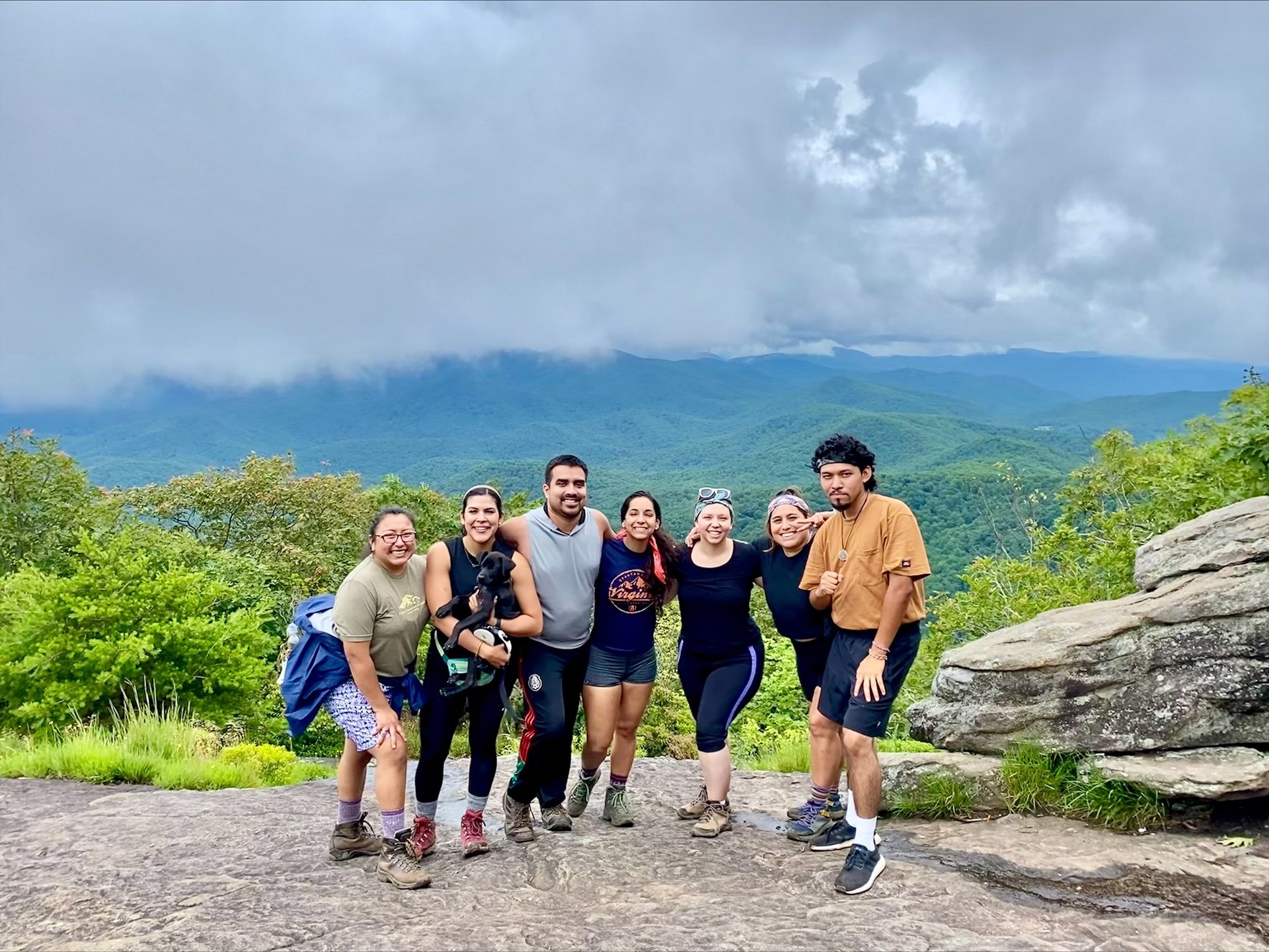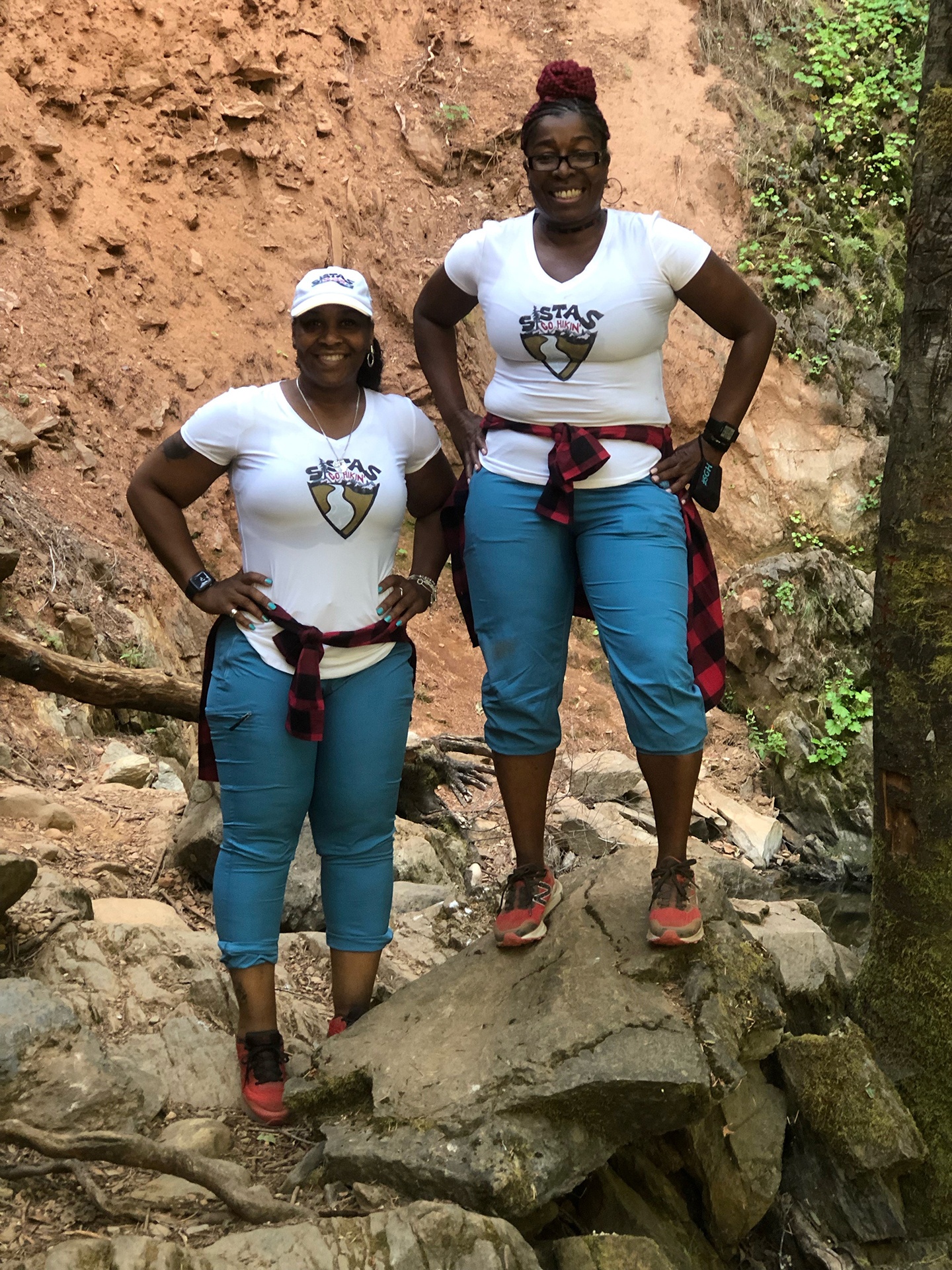By Kim O’Connell
Broadening the Base
September 2, 2021
This summer, a group of Latinx hikers from the Atlanta area hiked to the summit of Blood Mountain in north Georgia. At nearly 4,500 feet, Blood Mountain is the highest peak on the Appalachian Trail (A.T.) in Georgia, where hikers can find respite at the historic Walasi-Yi Interpretive Center, the only place where the Trail passes through a human-made structure, the center’s breezeway. Rain had failed to dampen the spirits of the group of seven hikers, who had gathered not just to summit the mountain, but to share their experiences in the outdoors.

A group of Latinx hikers from the Atlanta area hiked to the summit of Blood Mountain in north Georgia. Photo courtesy of Alexandra Garcia
“Part of the hike was a reflection,” says Alexandra Garcia, the Appalachian Trail Conservancy’s (ATC) Latinx Partnership Coordinator, who arranged the outing. “We talked about how we embedded conservation in our daily activities. It was a small group, so it was so intimate and special. We had to share more of ourselves; we were able to share information from our countries, knowledge of conservation, and our love for trails.”
After the hike, the group set up a picnic to continue the conversation. “We set up different foods—we had tacos, jicama, Puerto Rican party platters,” Garcia says. “We were able to bring our full selves to that space and never once feel like we were out of place. That’s my goal and the ATC’s goal moving forward.”
Garcia’s role is designed to help the ATC partner with Latinx communities that have traditionally been underrepresented on the Trail, primarily because of a lack of access and awareness, which often stems from long-standing societal barriers including racism, classism, and sexism. A 2020 report from the Hispanic Access Foundation and the Center for American Progress determined that communities of BIPOC (Black, Indigenous, and People of Color) are 74% more likely than white communities to live in “nature deprived” areas— meaning, those with little access to open green spaces. Just 23% of white communities lived in such areas.

The founders of Sistas Go Hikin’, Mellony Torres and Sonya Wynne, created the group because of their shared interest in being in nature and bringing people together. Photo courtesy of Sistas Go Hikin’
And yet, many BIPOC communities also have long traditions of connections with the outdoors, through farming, fishing, picnicking, or other outdoor sports, that white people don’t always understand or recognize. In a widely shared essay for Outside magazine called “We’re Here. You Just Don’t See Us,” writer Latria Graham noted, “The big takeaway—that black people dislike the outdoors—is wrong. I’ve loved the woods and wild places all my life, and the same is true for my family and friends.” In her piece, Graham cited a 2016 poll that found that 70% of BIPOC participated in outdoor activities on public lands.
Recognizing both the barriers and inequities, as well as the interest and opportunities, the ATC has affirmed its commitment to what is increasingly known as JEDI—justice, equity, diversity, and inclusion. Such work is not only right and just, but it’s necessary to expand the base of support that will be needed to sustain the A.T. and its communities throughout the rest of the twenty-first century, and to ensure that that base accurately represents the diversity of American society.
The ATC made broader relevancy a key tenet of its 2015 Strategic Plan, and since then, the Conservancy has initiated programs and projects that engage new and more diverse people and partners, including the Next Generation Advisory Council (NextGen) and Emerging Leaders’ Summit. The most recent Emerging Leaders’ Summit, held in August 2021, included JEDI-themed sessions on such topics as equity mapping, the process of using GIS technology to determine areas where outdoor amenities and resources exist or don’t exist, and mobilizing people to take action in both online and in-person ways.
“The Southeast has a large Latinx community, especially near the southern terminus of the A.T.,” Garcia says. “We’ve partnered with organizations that have an email list or a social media following to reach a wider audience and cast a wider net. Last month we organized both in-person and virtual events, with a focus on learning facts about the Trail, putting an emphasis on conservation.”
The goal, Garcia says, is not necessarily to encourage people to leave their jobs and go thru-hiking. “Many people, if they knew about thru-hiking, might have their minds blown,” she says. “In Puerto Rico, I had never heard of the A.T. I came from an island that’s 100 miles long, so the thought of thru-hiking 2,200 miles [for many people] is incomprehensible. But we hope that learning about it starts a culture of hiking and kindness on the Trail.”
Garcia is now focusing her outreach work on areas in the northeast with large Latinx communities that are not that far from the Trail, such as Washington, D.C. and New York City. The paramount concern is creating community and ensuring a quality time on the Trail, according to Garcia, versus a hard sell about conservation advocacy.
“I want to invite people in without the expectation that they become true advocates immediately,” she says, “Instead, I want to focus on the experience. You don’t truly advocate until you have a deep appreciation or deep love for something. In terms of the A.T., to be able to have that level of advocacy and appreciation that stems into sustainable action, people have to experience the Trail in multiple forms, sometimes over a long period of time.”
This is happening in myriad ways, not just on the A.T. but across the country. One group that is eager to get out on the A.T. is Sistas Go Hikin’, a group that formed in Sacramento in July 2020, during the still-early days of the pandemic. Founders Mellony Torres and Sonya Wynne were both athletes who enjoyed hiking, especially during the stressful lockdown period. “When everything was shut down, I was a little bit fearful,” Wynne says. “I was just stressed. When I went hiking, it was such a release for me. I realized I wanted to form a hiking group.”
Recognizing their common interests in the outdoors and bringing people together, Torres and Wynne formed the group to gather women of color for hiking trips, to help them get healthier, enjoy natural beauty, and learn more about conservation values such as Leave No Trace. In just one year, the Sistas Go Hikin’ Facebook group has amassed more than 400 followers, and the group has led both nature hikes and themed 5K walks. Some group hikes have brought out more than 40 women at a time. A Washington, D.C.-area chapter has now formed, founded by Ronda Stewart, and new chapters may soon be forming in Atlanta and Houston, too.
“We have all shapes and sizes, brown skin, dark skin, people who have never been on a trail, people who have never even walked [long distances] before,” Torres says. “But when you’re out there enjoying God’s beauty, before you know it, you’ve gone three miles.” The women already did one destination hike to the Red Rock wilderness outside Las Vegas, and they have plans to hike at Zion National Park and come east to the A.T., too.
“When we’re out on the trail, people aren’t expecting to see us,” Wynne says. “But we all have a right to be out there.” As groups like the ATC partner with more diverse communities, those societal expectations will change, and the number of advocates for the outdoors will grow along with it.
In fact, you don’t have to hike too far to see that it’s already happening.
